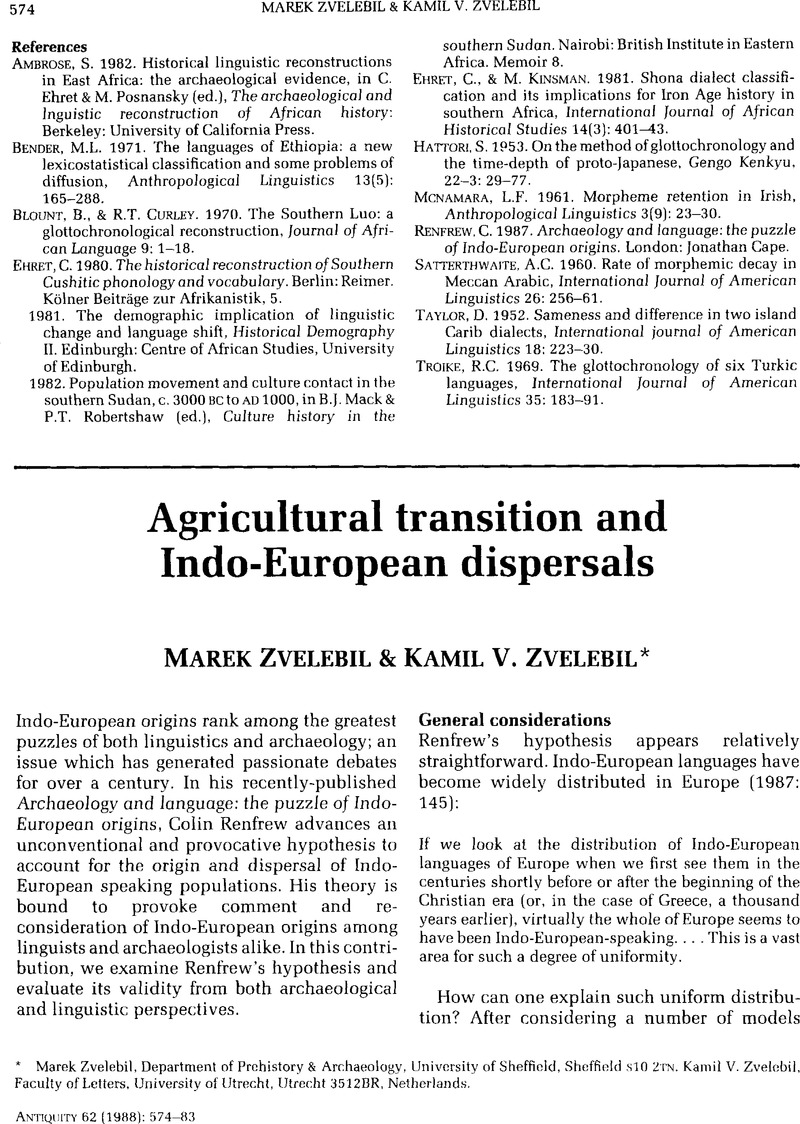Crossref Citations
This article has been cited by the following publications. This list is generated based on data provided by Crossref.
Ammerman, A. J.
1989.
On the Neolithic transition in Europe: a comment on Zvelebil & Zvelebil (1988).
Antiquity,
Vol. 63,
Issue. 238,
p.
162.
Renfrew, Colin
1989.
MODELS OF CHANGE IN LANGUAGE AND ARCHAEOLOGY.
Transactions of the Philological Society,
Vol. 87,
Issue. 2,
p.
103.
Zvelebil, Marek
1989.
On the transition to farming in Europe, or what was spreading with the Neolithic: a reply to Ammerman (1989).
Antiquity,
Vol. 63,
Issue. 239,
p.
379.
Schultze-Motel, Jürgen
1990.
Literatur über archäologische Kulturpflanzenreste (1988/1989).
Die Kulturpflanze,
Vol. 38,
Issue. 3,
p.
387.
Sokal, Robert R.
Oden, Neal L.
and
Wilson, Chester
1991.
Genetic evidence for the spread of agriculture in Europe by demic diffusion.
Nature,
Vol. 351,
Issue. 6322,
p.
143.
Zvelebil, Marek
and
Dolukhanov, Paul
1991.
The transition to farming in Eastern and Northern Europe.
Journal of World Prehistory,
Vol. 5,
Issue. 3,
p.
233.
Renfrew, Colin
1991.
Before Babel: Speculations on the Origins of Linguistic Diversity.
Cambridge Archaeological Journal,
Vol. 1,
Issue. 1,
p.
3.
Robb, John
1991.
Random causes with directed effects: the Indo-European language spread and the stochastic loss of lineages.
Antiquity,
Vol. 65,
Issue. 247,
p.
287.
Hines, John
1991.
Reviews.
Norwegian Archaeological Review,
Vol. 24,
Issue. 1,
p.
49.
Barber, E.J.W.
1991.
Review of L. Markey & Greppin (1990): When Worlds Collide: The Indo-Europeans and Pre-Indo-Europeans.
Diachronica,
Vol. 8,
Issue. 1,
p.
93.
RUIZ‐GÁLVEZ, MARISA
1991.
SONGS OF A WAYFARING LAD.
Oxford Journal of Archaeology,
Vol. 10,
Issue. 3,
p.
277.
Linke, Uli
1992.
Manhood, Femaleness, and Power: A Cultural Analysis of Prehistoric Images of Reproduction.
Comparative Studies in Society and History,
Vol. 34,
Issue. 4,
p.
579.
Robb, John
1993.
A social prehistory of European languages.
Antiquity,
Vol. 67,
Issue. 257,
p.
747.
Barbujani, Guido
Pilastro, Andrea
De Domenico, Silvia
and
Renfrew, Colin
1994.
Genetic variation in North Africa and Eurasia: Neolithic demic diffusion vs. paleolithic colonisation.
American Journal of Physical Anthropology,
Vol. 95,
Issue. 2,
p.
137.
Zvelebil, Marek
1995.
At the Interface of Archaeology, Linguistics and Genetics: Indoeuropean Dispersals and the Agricultural Transition in Europe.
Journal of European Archaeology,
Vol. 3,
Issue. 1,
p.
33.
Anthony, David W.
1995.
Horse, wagon & chariot: Indo-European languages and archaeology.
Antiquity,
Vol. 69,
Issue. 264,
p.
554.
Wilkinson, T. J.
1995.
Pavel Dolukhanov. Environment and ethnicity in the Middle East. (Worldwide Archaeology Series 7.) x + 406 pages, 123 figures. 1994. Aldershot: Avebury; ISBN 1-85628-706-8 hardback £45..
Antiquity,
Vol. 69,
Issue. 262,
p.
209.
Barbujani, Guido
Sokal, Robert R.
and
Oden, Neal L.
1995.
Indo‐European origins: A computer‐simulation test of five hypotheses.
American Journal of Physical Anthropology,
Vol. 96,
Issue. 2,
p.
109.
Wylie, Alison
1996.
Unification and Convergence in Archaeological Explanation: The Agricultural “Wave‐of‐Advance” and the Origins of Indo‐European Languages.
The Southern Journal of Philosophy,
Vol. 34,
Issue. S1,
p.
1.
Edwards, Kevin J.
Halstead, Paul
and
Zvelebil, Marek
1996.
The Neolithic transition in the Balkans - archaeological perspectives and palaeoecological evidence: a comment on Willis and Bennett.
The Holocene,
Vol. 6,
Issue. 1,
p.
120.





